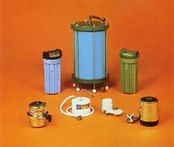
Our evaluation of home water treatment devices began with an examination of distillers. All three of the units that we discussed qualified as water purifiers (that is, the devices removed or killed all bacterial impurities), yet they crossed an impressively broad range of capability and cost. Similarly, the pieces of filtration equipment we're reviewing in this installment vary considerably in both capacity and price.
However, the seven filters we've had a chance to appraise do have one thing in common: They all employ activated carbon to filter out chemical impurities such as carcinogenic trihalomethanes. (Note: Although they, too, use charcoal, the General Ecology units rely on an even more effective microstraining system for their primary impurity removal.) Activated carbon — which is also called charcoal — has been used for cleansing for over 100 years . . . functioning, for example, as the stripping agent in World War I gas masks and as the medium used for decolorizing sugar. It's only recently, however, that the versatile material has come to be used in water filtration.
Because activated carbon's "cleaning" ability depends entirely on the amount of surface area contact between the cleanser and the water that's available, a filter's performance is largely determined by the volume of carbon inside it and the length of time the water remains in contact with the carbon ... a consideration which is called "residence time." Unfortunately, extensive residence time can result in the growth of bacteria on the charcoal . . . and each of the manufacturers included in our study has dealt with that problem in a different fashion.
source : motherearthnews.com
However, the seven filters we've had a chance to appraise do have one thing in common: They all employ activated carbon to filter out chemical impurities such as carcinogenic trihalomethanes. (Note: Although they, too, use charcoal, the General Ecology units rely on an even more effective microstraining system for their primary impurity removal.) Activated carbon — which is also called charcoal — has been used for cleansing for over 100 years . . . functioning, for example, as the stripping agent in World War I gas masks and as the medium used for decolorizing sugar. It's only recently, however, that the versatile material has come to be used in water filtration.
Because activated carbon's "cleaning" ability depends entirely on the amount of surface area contact between the cleanser and the water that's available, a filter's performance is largely determined by the volume of carbon inside it and the length of time the water remains in contact with the carbon ... a consideration which is called "residence time." Unfortunately, extensive residence time can result in the growth of bacteria on the charcoal . . . and each of the manufacturers included in our study has dealt with that problem in a different fashion.
source : motherearthnews.com
 RSS Feed
RSS Feed